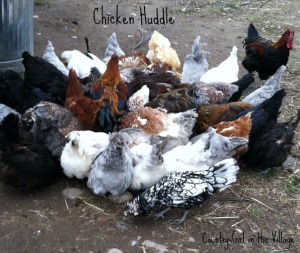by Shannon Cole
Story and photos
It’s January in Michigan. It is cold. How cold is it you ask? Today with the wind chill factor our local weather man says it is -4F. That is cold. It is the kind of cold that you can feel seeping in through your wood floors. It has to be too cold to go outside right? Nope. I still have to bundle up and go care for my chickens. It is what we chicken keepers do.

Keep Warm and Ventilated
People always ask me how do chickens stay warm in this kind of cold. I surprise them when I tell them we do not heat our coop. We do, however, rely on good planning and plain old genetics. We chose cold hardy breeds of chickens to keep. We give them a nice, dry, well ventilated coop. We supply them with fresh food and water.
That is all fine and dandy right? It is what we do, but how do they really stay warm? Instead of doing the Funky Chicken, they do the Funky Shiver. Chickens and other birds behave in certain ways to stay warm in extreme cold. Some of the things that your chickens will do is fluff, roost, huddle, tuck and shiver. Sounds technical, but you have probably noticed this in your flock all along.
Fluffing and Tucking
Chickens fluff in cold temperatures. The fluffing of their feathers create warm air pockets that are held close to their bodies trapping the air close. Chickens have perfectly designed feathers that work to keep them warm. They have the downy fluff close to their bodies, the varied length of the shafts and texture of feathers create a well designed layer over their bodies.
Tucking. Your chickens will tuck body parts as close to themselves as they can. Your birds will tuck their feet close to their bodies while they roost or pull up one foot at a time as they eat. A chicken’s feet have scale like texture and blood vessels that are designed to keep them warm but the bird will tuck them in when it needs too. Some birds will tuck their heads under wings or pull their necks in as close to their body as possible. Mothers will tuck their young in close to keep warm.

Roosting and Cuddling
Roosting. Your birds will roost even in daytime. If they are cold, they will get off the cold floor of a coop and the frozen ground and roost. It is important to make sure their roosting area is free of drafts.
Cuddle? Chickens also cuddle. Well, not really. Around here, we like to call it the huddle. Your flock will huddle close together in the cold to minimize exposure to the elements, but also to share body heat.

Cold hardiness all really comes down genetics. Birds are warm blooded, much like humans, and nature has a way of helping them regulate their temperature as well as some great adaptations that have evolved to give chickens and other birds, what they need to survive the climate in which they live.
Biologically, chickens and wild birds, have processes working that help to keep them warm in the cold months of winter. They are warm blooded, they have a high metabolism that turns food calories into the energy they need to stay warm and birds can control their temperature in a process called Torpor. Torpor is a physiological process that many animals go through where they slow down their metabolic rate and reduce their internal body temperature to stay warm.
Even on cold January days, your chickens will survive without a heated coop if you did your homework. As keepers we can ensure they have a clean, dry area with fresh food and water. We can add extra calories to their diet to help with what a chicken burns metabolically and electrolytes to their water. We can add extra bedding to ensure a warm insulated floor. Then, we let the chickens be chickens. They will shiver, they will tuck, huddle, fluff and roost and they will be ok.












